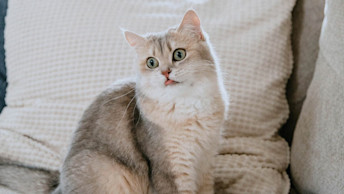August 12, 2021
How to Care for Your Cat's Teeth

Dental hygiene is as important for cats as it is for us. Periodontal disease can lead to the separation of teeth and gums, and the infection can spread to the heart, lungs, kidneys and blood stream, causing severe damage. Because cats are experts at hiding pain it is important to catch any issues before the disease progresses, and even better to prevent it all together with at home preventative care, and regular vet visits.
You can identify the disease early on by watching out for certain signs that your cat may be suffering from dental health problems. The earlier you notice any issues the easier they will be to correct or treat.
Signs of Periodontal Disease:
- Bad Breath
- Excessive drooling and/or nasal discharge
- Discoloured or bleeding gums
- Not eating or dropping the food into a water bowl to soften it
- Yowling or pawing at the face while eating
- Missing, broken, or loose teeth
Preventative Care
There are several things you can do at home to ensure your cat’s teeth and gums stay as healthy as possible. Preventative care can be routine or more laboured, but it’s all preferable to the alternatives, such as expensive vet bills, or a very sick feline.
Dental Care at Home:
- Good quality and healthy dry food
- Additives you can put in the water that help stop tartar and plaque build up
- Dental sprays, and oral rinses, that you can apply to the teeth and gums
- Toys that encourage chewing
- Brushing the teeth
Good quality food that contain enzymes and supplements that help the buildup of plaque. Many poor quality foods contain ingredients that actually stick to teeth. Dry kibble is important for healthy teeth, but do not forget that wet food also plays an important role in your cat’s health. So make sure your cat gets a good balance of both, and never forget a constant supply of fresh water is essential.
When it comes to brushing there are various types of brushes, and flavoured toothpastes, that you can try out on your cat. Stay away from human brushes and toothpastes as they were not designed for felines. Brushing may not be an easy endeavour, but even a quick brush here and there is better than no brushing at all.
Ask your vet or check with a retailer for all the other “dental care” options available. Rinses, water additives, and specialty toys are all relatively easy methods to stay on top of your cat’s dental health.
Your Vet's Role in Dental Hygiene
Typically dental problems do not start until your companion is about three years old. Dental disease takes some time to develop, and tartar build up in the first couple of years is typically not substantial enough to cause any problems, or require any treatments.
At about three years regular dental check ups, and possibly cleaning, become important. Your vet can determine if there are signs, such as tartar or plaque build up, that require a dental cleaning.
Based on your cat’s age, general health, and genetics your vet will also be able to tell you if annual, or semi annual visits are necessary. Like us, some cats just have more dental issues than others, regardless of what we do. Sometimes x-rays are needed to get a better idea of what is happening, and what treatments are necessary.
Regular dental maintenance such as cleaning is a lot less expensive, intrusive, and painful than dental disease and major teeth extractions.
Healthy teeth and gums are a large part of what keeps your feline companion happy, healthy, and active. Good food, oral care, and regular vet check ups will keep your cat smiling for many years to come.



